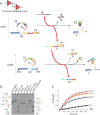Allosteric DNAzyme-based DNA logic circuit: operations and dynamic analysis
- PMID: 30541100
- PMCID: PMC6379719
- DOI: 10.1093/nar/gky1245
Allosteric DNAzyme-based DNA logic circuit: operations and dynamic analysis
Abstract
Recently, due to the dual roles of DNA and enzyme, DNAzyme has been widely used in the field of DNA circuit, which has a wide range of applications in bio-engineered system, information processing and biocomputing. In fact, the activity of DNAzymes was regulated by subunits assembly, pH control and metal ions triggers. However, those regulations required to change the sequences of whole DNAzyme, as separating parts and inserting extra DNA sequence. Inspired by the allosteric regulation of proteins in nature, a new allosteric strategy is proposed to regulate the activity of DNAzyme without DNA sequences changes. In this strategy, DNA strand displacement was used to regulate the DNAzyme structure, through which the activity of DNAzyme was well controlled. The strategy was applied to E6-type DNAzymes, and the operations of DNA logic circuit (YES, OR, AND, cascading and feedback) were established and simulated with the dynamic analyses. The allosteric regulation has potential to construct more complicated molecular systems, which can be applied to bio-sensing and detection.
© The Author(s) 2018. Published by Oxford University Press on behalf of Nucleic Acids Research.
Figures






Similar articles
-
Constructing Controllable Logic Circuits Based on DNAzyme Activity.Molecules. 2019 Nov 15;24(22):4134. doi: 10.3390/molecules24224134. Molecules. 2019. PMID: 31731630 Free PMC article.
-
Entropy-driven DNA logic circuits regulated by DNAzyme.Nucleic Acids Res. 2018 Sep 19;46(16):8532-8541. doi: 10.1093/nar/gky663. Nucleic Acids Res. 2018. PMID: 30053158 Free PMC article.
-
DNAzyme-Based Logic Gate-Mediated DNA Self-Assembly.Nano Lett. 2016 Jan 13;16(1):736-41. doi: 10.1021/acs.nanolett.5b04608. Epub 2015 Dec 11. Nano Lett. 2016. PMID: 26647640
-
DNAzymes for sensing, nanobiotechnology and logic gate applications.Chem Soc Rev. 2008 Jun;37(6):1153-65. doi: 10.1039/b718428j. Epub 2008 Apr 24. Chem Soc Rev. 2008. PMID: 18497928 Review.
-
DNAzyme-based biosensors for mercury (Ⅱ) detection: Rational construction, advances and perspectives.J Hazard Mater. 2022 Jun 5;431:128606. doi: 10.1016/j.jhazmat.2022.128606. Epub 2022 Mar 3. J Hazard Mater. 2022. PMID: 35278952 Review.
Cited by
-
A DNA Finite-State Machine Based on the Programmable Allosteric Strategy of DNAzyme.Int J Mol Sci. 2023 Feb 10;24(4):3588. doi: 10.3390/ijms24043588. Int J Mol Sci. 2023. PMID: 36834996 Free PMC article.
-
Sensitive Detection of Nucleic Acids Using Subzyme Feedback Cascades.Molecules. 2020 Apr 10;25(7):1755. doi: 10.3390/molecules25071755. Molecules. 2020. PMID: 32290237 Free PMC article.
-
Constructing DNA logic circuits based on the toehold preemption mechanism.RSC Adv. 2021 Dec 22;12(1):338-345. doi: 10.1039/d1ra08687a. eCollection 2021 Dec 20. RSC Adv. 2021. PMID: 35424506 Free PMC article.
-
DNA Matrix Operation Based on the Mechanism of the DNAzyme Binding to Auxiliary Strands to Cleave the Substrate.Biomolecules. 2021 Nov 30;11(12):1797. doi: 10.3390/biom11121797. Biomolecules. 2021. PMID: 34944442 Free PMC article.
-
Controllable and reusable seesaw circuit based on nicking endonucleases.J Nanobiotechnology. 2024 Apr 1;22(1):142. doi: 10.1186/s12951-024-02388-6. J Nanobiotechnology. 2024. PMID: 38561751 Free PMC article.
References
Publication types
MeSH terms
Substances
LinkOut - more resources
Full Text Sources

